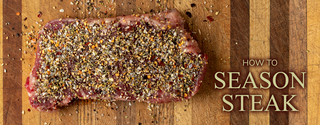How To Season A Steak
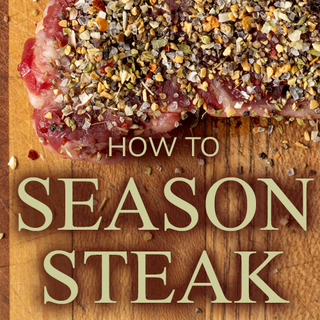
How to Season A Steak
When you season your steak, always…always…start with salt. While there are other spices and seasonings that you can use to enhance the flavor of your favorite cut of steak, chefs across the country agree that salt is the #1 way to make your steak taste great1.
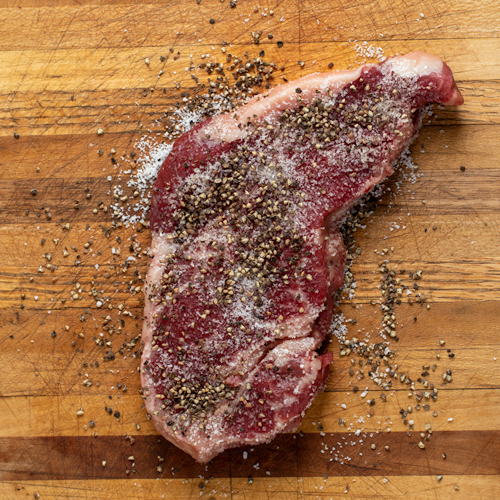
Preseasoning with coarse sea salt or kosher salt is a simple and practically effortless way to boost a steak’s flavor and tenderness. To preseason, put a layer of salt on your steak and let it sit on the counter for about 45 minutes. This completes two steps to making great steak; it will let the salt work its magic on the flavor as you allow the steak to come up to room temperature, which helps ensure that a steak will cook evenly.
During those forty minutes, salt will start to draw moisture from the muscle, creating a sort of instant brine as the salt melts with the moisture and reabsorbs into the meat. It helps make meat juicy and gives it a layer of flavor before adding other seasonings. You can further season the steak before you’re ready to cook; we’ll talk about that in a moment.
For over a decade, Spices, Inc. has operated under one premise: to provide the spices, herbs, and seasoning blends that help make your food taste great. We’re committed to finding the best products available. Once we get a product or create a new seasoning blend, we run it through numerous tests in our test kitchen. This way, we can get familiar with our products, know how to use them, and offer our customers top-notch advice and top-quality spices.
What Spices Go Best With Steak?
Our favorite spices when cooking steaks in our test kitchen are black pepper, garlic, cayenne, cumin, and onion. Beef has a strong flavor profile, so it can stand up to spices and herbs that are spicy and bold and impart a rich aroma. You can balance its inherent depth with a little bit of sweetness or herbaceousness. Just remember that salt is mandatory, and you’ll need to season your steak thoroughly to maximize flavor.
Choose spices with intense flavors that will accentuate the taste of your steak without overpowering it. We encourage you to experiment with how these spices combine to find the blend you like best. When ready to move forward, we invite you to look at our top spice choices for beef to expand your palate.
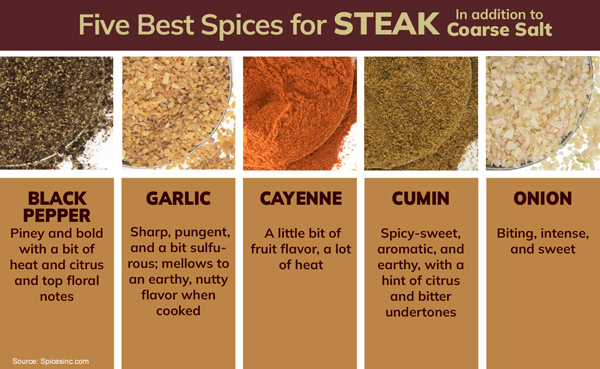
| Black Pepper | Piney and bold with a bit of heat and citrus and top floral notes. Coarse pepper adds a terrific, stand-out texture, so choose something with a bit of bite rather than a fine pepper |
| Garlic | Sharp, pungent, and a bit sulfurous; mellows to an earthy, nutty flavor when cooked |
| Cayenne | A little bit of fruit flavor, a lot of heat |
| Cumin | Spicy-sweet, aromatic, and earthy, with a hint of citrus and bitter undertones |
| Onion | Biting, intense, and sweet |
We cannot stress enough that salt is necessary for flavorful steak, so it will always be on our list of steak seasonings. Make sure you use coarse salt, like Kosher salt. Fine salt, like table salt, will absorb too quickly into your meat. You risk oversalting and thus ruining your steak if you toss it with table salt. It’s best to consider salt indispensable to cooking steak.
Five Best Herbs for Steak
Herbs will help lift the flavors of a steak from the depths; the meat's rich flavors and the spices' robust flavors can get a little too deep if you don’t have something lighter that can provide balance.
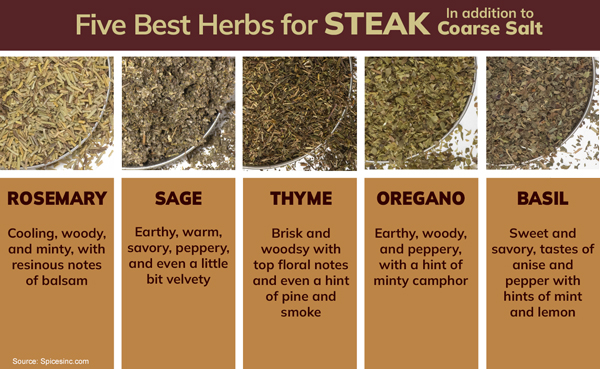
| Rosemary | Cooling, woody, and minty, with resinous notes of balsam |
| Sage | Earthy, warm, savory, peppery, and even a little bit velvety |
| Thyme | Brisk and woodsy with top floral notes and even a hint of pine and smoke |
| Oregano | Earthy, woody, and peppery, with a hint of minty camphor |
| Basil | Sweet and savory, tastes of anise and pepper with hints of mint and lemon |
Five More Favorite Seasonings for Steak
To create a special, unique steak seasoning, you may want to mix some flavors that may be unexpected but complementary to a top-notch steak. These spices give your steak a unique touch; they can add smoke or heat or a bit of sweetness and help you create a meal that’s entirely your own.
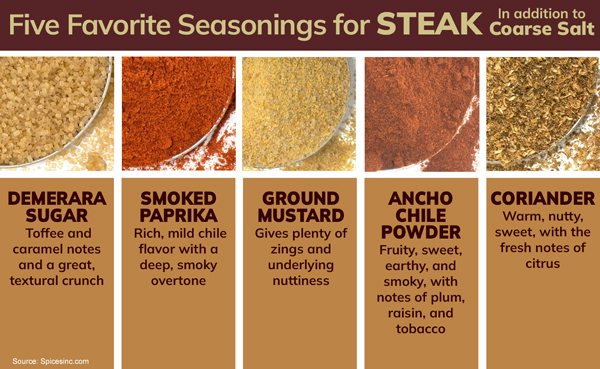
| Demerara Sugar | Toffee and caramel notes and a great, textural crunch |
| Smoked Paprika | Rich, mild chile flavor with a deep, smoky overtone |
| Ground Mustard Powder | Gives plenty of zings and underlying nuttiness |
| Ancho chile powder | Fruity, sweet, earthy, and smoky, with notes of plum, raisin, and tobacco |
| Coriander | Warm, nutty, sweet, with the fresh notes of citrus |
Homemade or Store Bought Seasonings
Making a homemade steak seasoning vs. using a ready-made blend purchased from a store or spice vendor is a matter of personal preference. Both options have their pros and cons.
Store-bought seasonings are usually well thought out and taste tested to check that spices are balanced and create a compatible flavor with a steak. Good blends are generally a convenient shortcut to a delicious meal.
You should always check the ingredient list, though. You don’t want a pre-made blend to be made predominantly of salt, even though it is essential to the overall outcome of the steak. Salt can be overdone and is a cheap addition to a pre-made blend; if you buy something that’s got garlic and onion salt on top of salt as an independent ingredient, you’ll likely throw the flavors out of balance.
You would be better off sticking to a simple seasoning of the salt and pepper at home instead of spending time on a blend that won’t work.
A homemade seasoning blend takes a little more effort, but it’s much more adaptable to the steaks you’re cooking. You can cater a combination to your tastes and tinker with your preferred ingredients until you hit your signature blend.
Creating the perfect blend takes trial and error, so you might not immediately have the combination you want. Keep working at it, and eat the mistakes!
The first thing you need to do when you make a steak blend is to think about what flavors you like. Do you like a strong garlic presence? How about the bite of black pepper? Or, pick a few seasonings from each list and combine them. As for salt, you'll certainly have to add that in, but you can do so after you've chosen your other seasonings. Add as much as necessary; you will probably need at least as much as the most dominant ingredient in your blend.
To get started, try playing with these combinations. Increase or decrease these seasonings to match your personal preferences.
- 2 parts salt, 2 parts black pepper, 2 parts garlic, 1 part rosemary, ½ part demerara sugar
- 2 parts salt, 1 part black pepper, 1 part cumin, 1 part coriander, 1 part ground mustard
- 1 part salt, 1 part black pepper, 1/2 part sage, 1/2 part thyme, 1 part smoked paprika
The possibilities are wide open! Once you have the combination you want and add salt, you can start cooking.
When Should You Season Your Steak?
It would help if you always seasoned your steak before you cooked it, but you must consider a few things before pulling out your salt cellar.
You could toss your steak in a coating of salt and let it sit in the salt for at least 45 minutes. Some experts suggest you can leave your steak in the salt for up to 48 hours, but we think just one night in salt is enough. If you plan to leave the steak in the salt for more than an hour, put it in the refrigerator with no cover. When you do this, you create a dry brine which helps to tenderize the steak and keep it juicy.
If your dry-brined steak is in the refrigerator, let it come up to room temperature for about half an hour before cooking it. Wipe any visible salt from the steak and pat it dry with paper towels. Then reseason with salt and your preferred selection of spices.
If you do not dry brine your steak, let it come up to room temperature for about half an hour. Right before you are ready to cook, season your steak. Put it on a hot grill or pan and cook.
We recommend that you pat your steak dry before seasoning it for cooking. A steak with a damp exterior will not sear correctly; it will steam on the cooking surface instead of adhering to it to create a richly flavored and texturized exterior.
Once your steak has reached your desired doneness, and you’ve let it rest, re-season the steak just before serving. The final seasoning should use large-grain or flaky salt to give texture and flavor.
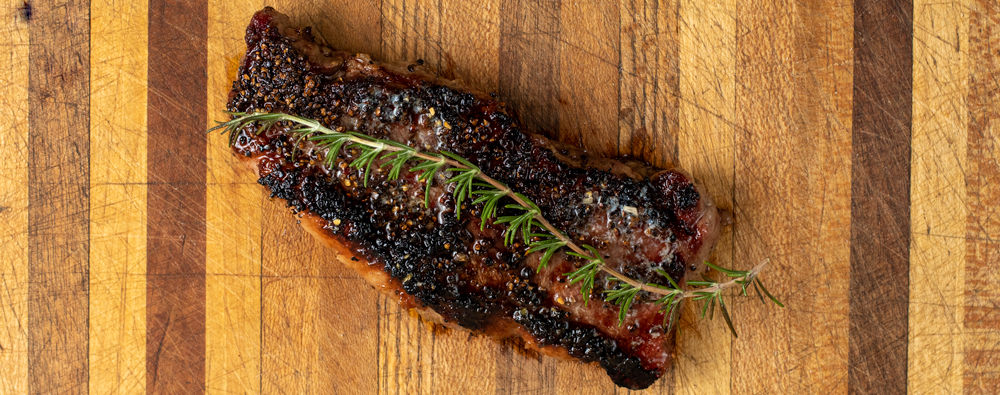
How Much Do I Need to Use?
Use more seasoning than you think you’d need for a steak. Imagine that you’re wrapping your steak in a snug blanket of seasonings.
There are conflicting beliefs on how much seasoning is needed to season your steak. The suggestions range from as little as ¾ teaspoon of a seasoning per pound to 1 Tablespoon of seasoning per pound. We believe that the guideline should be to season your steak thoroughly. Ensure a seasoning coating on the steak’s top and bottom, and don’t forget to season the sides. Since you’ll also be seasoning at the end of cooking, you have the opportunity to add a little bit more seasoning if you think it needs a boost.
Ways to Cook Steak
There are several ways to cook a steak. The most popular methods are stove-top cooking, grilling, and searing on a stove before finishing it in the oven. There’s another method called reverse searing that is gaining attention and popularity.
With every cooking method, you need to determine beforehand if you will do a more extended, dry brine or if you plan on simply seasoning your steak right before you cook it. Our descriptions of different cooking methods will begin with the steps to take before the steak goes over the heat.
Our instructions are written for steaks between 1 and 1 ¼ inches thick. Cooking time for thicker or thinner steaks should be adjusted accordingly. We use canola oil when cooking steaks because it has a higher smoke point—the point at which the oil will start to burn—than other cooking oils. You can use any oil you prefer, but we heartily suggest that you choose an oil with a high smoke point since that can negatively affect the flavor of the steak.
To accurately assess the doneness of your steak, use a meat thermometer.
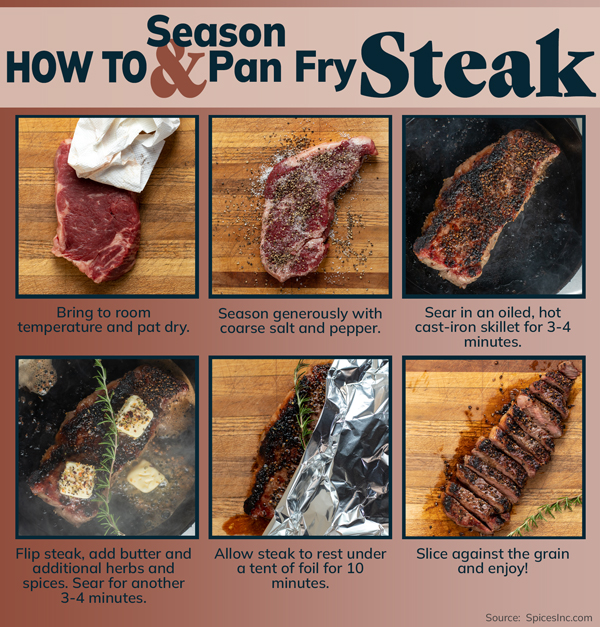
How to Pan Sear a Steak On the Stove Top
- Let the steak come up to room temperature for at least 30 minutes.
- Pat steak dry with paper towels and season generously with coarse salt and pepper.
- Put a cast iron or stainless steel pan on a burner and let it warm on the hot burner for 5 minutes, or until it is very hot. Pour a thin layer of canola oil into the pan.
- Carefully lay the steak in the pan. Let it sear for 3-4 minutes, or until the bottom of the steak looks golden and has started to char.
- Flip the steak once. Add butter and additional seasonings or a blend if desired. Baste steak with butter for another 3-4 minutes or to preferred doneness.
- Remove from heat and transfer the steak to a plate or cutting board.
- Let the steak rest under a foil tent for 10 minutes before serving. Slice and enjoy!
How to Cook Steak on the Grill
- Let the steak come up to room temperature for at least 30 minutes.
- Pat steak dry with paper towels and season generously with your preferred seasoning.
- Rub canola oil on the grill. Heat your grill to high heat, and let it run at high heat for about 10 minutes. If you have zones or can create them on your grill, make one zone a cooler zone. This would be used if the inside of the steak needed to cook a little longer, but the outside of the steak was sufficiently charred.
- Put the steak on the grill. Let it sear for 3-4 minutes, or until the bottom of the steak looks golden and has started to char.
- Flip the steak once. Let it cook for another 3-4 minutes or to the desired doneness. Move to the cooler zone to continue cooking if necessary.
- Remove from heat and transfer the steak to a plate or cutting board.
- Let the steak rest under a foil tent for 10 minutes before serving. Slice and enjoy!
How To Cook Steak in the Oven
- Let the steak come up to room temperature for at least 30 minutes.
- Preheat the oven to 400°F; put an oven-proof pan—cast iron is best—on the stove over high heat.
- When the pan is hot, and the oven is warmed and ready, put canola oil in the pan.
- Pat steak dry with paper towels and season generously with your preferred seasoning.
- Sear until a rich crust has formed. Flip once and sear the other side.
- When steaks are browned, put them on the hot stove to finish cooking; plan for 5-7 minutes for a medium-rare steak. Please remove it from heat and move it to a cutting board at your preferred doneness.
- Let the steak rest under a foil tent for 10 minutes before serving. Slice and enjoy!
Alternatively, you can cook a steak under your oven’s broiler. In that instance, take these steps.
- Let the steak come up to room temperature for at least 30 minutes.
- Preheat your broiler and move your oven rack to the highest shelf in the oven.
- When the oven is hot, spread some canola oil over a baking tray that won’t buckle in high heat.
- Pat steak dry with paper towels and season generously with your preferred seasoning.
- Put under your hot broiler and let it sear for about 5 minutes. Slide the rack from the oven and carefully flip the steak over.
- Return it to the oven and cook for another 3-5 minutes or so, depending on the thickness of the steak and your preferred doneness.
- Remove steak from the oven and transfer it to a cutting board. Let the steak rest under a foil tent for 10 minutes before serving. Slice and enjoy!
How to Reverse Sear
A reverse sear is a relatively new method of cooking steak that’s gaining popularity. To reverse sear, cook the steak in the oven first, and move it to a hot pan at the end to create the rich crust we all crave.
Proponents of the reverse sear swear by its ability to cook steak evenly and deliver a tender, juicy meal, though it comes at a price; the reverse sear takes longer than other cooking methods. Bear in mind that it works best on thicker steaks and roasts.
- Let the steak come up to room temperature for at least 30 minutes.
- Preheat oven to 250°F.
- Pat steak dry with paper towels and season generously with your preferred seasoning.
- Place steak on an oven-proof wire rack set over a rimmed baking tray. Airflow is essential for all-over cooking with this method.
- Cook steaks until they are approximately 10-15°F cooler than the desired temperature; for 1½-inch thick steaks, this can take 25-30 minutes for a medium-rare steak.
- As the steak is cooking, heat a pan on the stove over high heat.
- When the steak is at the necessary temperature, remove it from the oven. Put canola oil in the pan, and then put in your steak—Cook for about 2 minutes per side, or until you’ve reached your preferred level of doneness.
-
Transfer steak to a cutting board. Let the steak rest under a foil tent for 10 minutes before serving. Slice and enjoy!
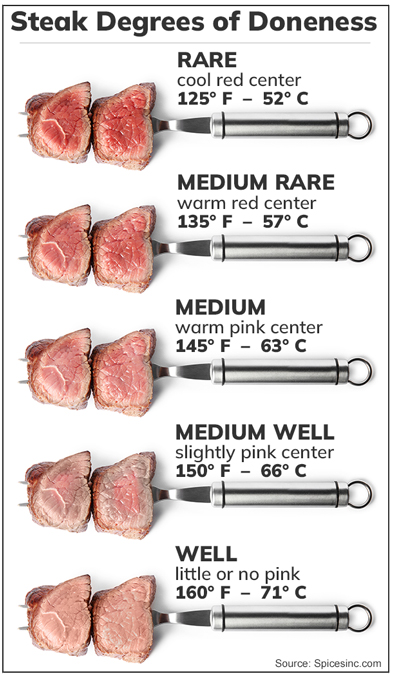 How To Tell If Your Steak Is Cooked
How To Tell If Your Steak Is Cooked
A steak’s doneness is determined by its internal temperature, and the simplest and most accurate way to guarantee internal temperature is to get a meat thermometer.
When you use a meat thermometer, you insert a pointed probe into the center of the meat without touching the bone or the cooking surface. Leave it there until the temperature gauge stops moving, which should take seconds, and voila! You’ll know how well your steak has been cooked. Please see our chart on internal temperatures to determine how well-done you’d like your steak.
Some sources may discuss a “hand test”, which compares the density of various parts of the hand to the doneness of a steak. It’s based on the idea that protein tightens as it cooks, so a more thoroughly cooked steak will feel harder.
This can be used as a general guideline to see if a steak is cooking and is ready for a test with a thermometer, but it cannot be relied upon as the only way to check for doneness. The only way to do that is with a thermometer.
Steak is a classic American dinner. It can seem intimidating when you start cooking steaks to get them right, but all you need to do is master a few basics, and you’re on your way to a dinner that tastes great and will make you the envy of your friends. To review:
Always use coarse salt. Choose strong seasonings that can stand up to the heartiness of steak. Season more than you think you should. Try unexpected seasonings that can give your meat a signature flavor. Don’t be afraid to experiment!
References
1. López-Alt, J. K. (2015). The Food Lab: Better Home Cooking Through Science. W.W. Norton & Company, Inc.

